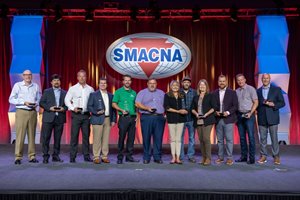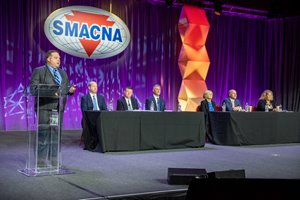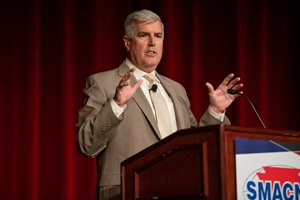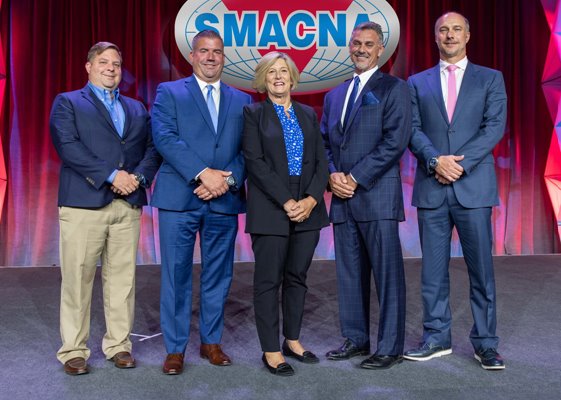“Change is inevitable. Growth is optional.”
This infamous quote by leadership author and speaker John C. Maxwell was a continuous theme heard throughout SMACNA’s annual convention, which welcomed nearly 1,000 attendees from Sept. 11 – Sept. 14 to Colorado Springs, Colorado.
Big changes continue to happen across the industry — from workforce challenges to selective supply chain issues to an increasing need for technology to remain competitive. The association is also working on its own processes and services, addressing things such as increasing engagement and membership, strengthening its chapters, building stronger ties with the labor union, and coming up with a strategic plan to determine its path forward, according to SMACNA CEO Aaron Hilger.
“Most of us have a lot of business in the pipeline but trouble finding the labor to do the work,” said Tony Kocurek, SMACNA’s new president. “We have federally funded programs with prevailing wage mandates, registered apprenticeship requirements, as well as buy American. We have strong labor partners and an association that supports all our needs.”
“Filling these jobs won’t be easy, but it must be done,” Hilger added. “Finding solutions is necessary.”
“This is our moment,” explained Joseph Sellers, Jr., general president of SMART, the international association of sheet metal, air, rail, and transportation workers. “We are poised to see the growth of our companies, growth in SMACNA, and growth in SMART. And we must do this together. We must come together and have trust in each other to grow nationally and locally.”
Here are some of the major topics covered during networking opportunities, the trade show, and numerous, relevant educational sessions that help members address and adapt to constant change.
2022 Futures Study Update
Speakers Angie Simon, advisor to the board of Western Allied Mechanical, and Guy Gast, president, Iowa division, The Waldinger Corp., shared trends from the 2022 Futures Study, how they impact SMACNA contractors, and what steps they recommend for conquering these challenges.
The session examined project risks contractors can expect to face now and into the future, including retaining a skilled workforce to meet growing demand, post-pandemic supply chain disruptions and calamitous contracts, to name a few.
First, the workforce shortage is expected to continue, highlighting risks to the industry's work pipeline that will only be fully realized with adequate labor. Contractors who embrace diversity in their organizations won't be impacted as much as those who don't. To stay ahead of this, Simon and Gast suggest contractors increase recruiting, create pipeline programs like the Heavy Metal Summer Experience and internships, boost inclusion, and beef up onboarding and mentoring programs.
Supply chain and contract risks are also expected to continue, but they will be more specific to individual products and supplies and not as pervasive as they were in the recent past, Simon and Gast revealed.
To reduce risk and increase productivity, Simon and Gast advised contractors better manage contracts to protect themselves. Additionally, learning more about their target markets, educating customers and exceeding customer expectations will be key ways to build client loyalty. Also, using technology like BIM (building information modeling) is not an option anymore for those contractors who want a seat at the table with certain clients; the use of BIM will continue to evolve to effectively tackle complex projects and work within tighter project schedules.
National demand for HVAC services and construction is expected to grow as a result of increasing building activities, infrastructure funding and necessary HVAC replacements and upgrades.
“Faced with labor shortages, compressed schedules, and price constraints, contractors will be compelled to innovate and deliver more with the same or fewer resources,” Gast said.
“Change is the only constant out there,” Simon said. “Change is all around us in the industry now. Learning about new opportunities is the only way to grow your business and adapt to this change.”
Developing Better Communication to Attract Employees
Many of the key speakers at the SMACNA annual convention focused on improving communication and handling conflict to streamline business operations and attract and retain top-performing employees.
Ann Rosser, principal at Finding Resolution Consulting, said during her session called “Handling Conflict with Collaborative Communication” that fights left to fester in an organization only magnify struggles.
Leaders in a business can sometimes be too distracted or exhausted to address the root cause of negative situations in their organizations. To improve, leaders can identify listening blocks, use techniques to shift conflict situations into problem-solving modes, and use simple phrases to frame disagreements more constructively.
“After all, employees perform better when they are in situations where they feel like they belong,” added speaker D.J. Allen with Xs and Os of Success, a leadership, organizational and professional development company that uses the platform of sports life lessons to help individuals and teams maximize their potential, during his three educational sessions, “Creating a Collaborative Environment,” “Communicating for Results,” and “Great Leaders are Great Teammates.”
Business leaders, like coaches of a team, can put their employees (or team players) in the right positions to make a positive impact on their results. To do this, Allen recommended that leaders be upbeat, consistent, good communicators and efficient. “You will find success in your results if you spend time creating the proper environment,” Allen said.
What also helps is recognizing the differences between being a top producer in a business and being a leader. “Just because you’re a good player does not mean you will be a good coach — it’s a different mindset,” Allen said. “To be a strong leader, you need to understand how to be a good teammate and why teams work and why they don’t.”
A leader’s verbal and non-verbal communication is important to create this positive culture. Remember, “It’s not about what you say; it’s about what they hear,” he said.
Mike Clancy, partner and strategy practice leader at FMI, agreed that improving employee engagement is a top to-do for contractors looking to attract and retain workers during his session, “The Changing Project Risk Environment.”
Turnover in the construction industry has doubled in the last five years, driven by a lot of factors, he said. “But, ultimately, people leave jobs because they are not engaged,” Clancy explained. “Make sure your employees see a future for themselves and get along with their teammates and supervisors. Those three things can knock out any disengagement issues.”
Technology Trends Abound
Amid major industry changes that are outside of contractors’ control, such as price changes, supply chain issues, regulations and economic challenges, learning how to adapt and better navigate these business disruptions is how contractors can thrive.
“You have to have good processes to consistently manage risk and get a feedback loop going in your business,” Clancy advised.
By recognizing and quantifying risks, you can be more prepared as a business owner, he said. “If you can see risk and put a value on it, then when it does occur, you can make a more informed business decision when you respond to it,” Clancy explained.
One way to adapt to and better manage risk is with new technology that simplifies business and saves time and labor.
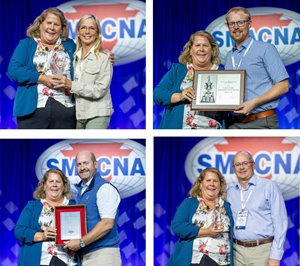
Angie Simon presenting awards to Karen Fox, Nathan Cooper (top, left to right) and Jack Knox and John Sindyla (bottom, left to right).
2022 Award Winners
Contractor of the Year:
Jack Knox, RF Knox Co., Smyrna, Georgia
Chapter Executive of the Year:
Nathan Cooper, executive director of SMACNA Colorado, Denver, Colorado
Legislative Contractor of the Year:
Karen Fox, Precision Air Balance Co., Anaheim, California
Chapter Executive Legislative Advocate of the Year:
John Sindyla, SMACNA Cleveland
For instance, during his talk on “Augmented Reality and Artificial Intelligence,” Ian Warner, construction systems architect, Trimble Digital Delivery Services, suggested contractors focus on the following to help get jobs done on time amid labor shortages:
- Optimizing details in design and preconstruction — Doing this can make sure logistics and materials are set so contractors can reduce labor needs during the project.
- Prefabrication and modulization — Prefabrication can have a dramatic impact on schedule performance, construction costs, and workplace safety. By prefabricating where possible, contractors can design, build and load finished materials, going straight from the fabrication area to get final materials to the jobsite. But this all depends on the contractor having a business model that makes this possible.
- Digital project management — Many times, contractors on a job aren’t playing from the same sheet of music when it comes to updates or changes. “If you’re not working off of the latest plans or change orders, you’re risking having to do costly rework,” Warner said. “Having quality checks and assurances in place and all updates in the same project management location can streamline the process.”
-

A sweeping view of the College of Fellows Golf Tournament at The Broadmoor West Course in Colorado Springs, Colorado.
Digital layouts and as-builts using 3-D modeling — Using an architect’s 3-D model can ensure more accurate measurements, as can checking measurements while workers sleep, such as using Spot the Robot Dog from Trimble and Boston Dynamics. This machine uses a laser scanner on an autonomous robot to create 3-D imagery of a space and compare it against CAD/BIM models to improve accuracy. Laying out a 3-D model and building to a 3-D plan using autonomous robotic solutions can help get things done right, maximizing job productivity.
Another time-consuming aspect of running a business that involves risk is contracts. In fact, 75 percent of contractors say reviewing contracts is a big pain point for them, 60 percent say it takes them more than one day to review a contract, and 81 percent of contractors say they’ve been hurt financially by another party using a contract against them, according to Josh Levy, CEO and founder of Document Crunch.
Contractors are beginning to use software today to help quickly scan legal documents for concerning language to alert them before they sign on the dotted line. This saves them from paying lofty legal fees, waiting days to be able to get contract language reviewed or from potentially losing money by signing a contract that could put them at risk.
Levy said contractors who better understand contract language and negotiating contracts can:- Reduce overhead, which means more profit
- Reduce fee erosion or the likelihood of someone using a contract against them
- Increased pricing efficiency to drive profitability
- Reduce litigation
Introducing The 2022-2023
Executive Committee
CEO: Aaron Hilger, SMACNA
President: Tony Kocurek, owner of Energy Balance &
Integration, LLC, Albuquerque, New Mexico
President-Elect: Carol Duncan, CEO and owner of
General Sheet Metal, Clackamas, Oregon
Secretary-Treasurer: Tom Martin, president,
T.H. Martin, Cleveland, Ohio
Vice President: Todd Hill, president Ventcon,
Allen Park, Michigan
Immediate Past President: Al LaBella (not pictured),
owner and president of Blue Diamond Air Systems, Medford, New York
New Directors:
Bernie Antchak, NW Sheet Metal, British Columbia, Canada
Matt Cramer, Dee Cramer Inc., Holly, Michigan
Kathleen Kerber, KSM Metal Fabrication, Troy, Ohio
Ken Kleeberg, Yankee Sheet Metal, East Hartford, Connecticut
Matt Sano, Fisher Balancing, Williamstown, New Jersey
Another key session, “Everything You Need to Know About Laser Welders,” informed attendees on cutting-edge laser welding technology, as well as provided training and safety tips for using this equipment. Michael Harris, program director for iTi, shared grant information available for this machinery, while Luke Bland, director of client services at Poynter Sheet Metal in Greenwood, Indiana, and John Keating, sales manager of the western region at IPG Photonics, talked about available uses for laser welders, showcased sample welds and described set-up requirements.
Additionally, SMACNA’s technical services staff had multiple sessions informing members on new projects and research updates, including new duct design standards, as well as updates to SMACNA’s Guide for Free Standing Steel Stack Construction and a look into the fourth edition of the Seismic Restraint Manual due to be out in 2023.

Gerry O'Brion (left) says "your customers don't want a better relationship, they want a more valuable relationship."
Marketing Tips from Big Brands
In crowded, competitive, commoditized markets, how can contractors convince customers to buy from them over others?
Keynote speaker Gerry O’Brion, founder of What Big Brands Know, simply said they must “give customers more of what they want and less of what they don’t.”
Easier said than done, O’Brion offered some relevant examples, such as how Amazon makes it so easy to do business with customers, giving them insight on their packages from the moment they place orders to the time they ship and even through various stages of their delivery journeys. “Your customers don’t want a better relationship,” he explained, “they want a more valuable relationship.”
As customers make decisions, they need reasons to choose you over others. To get more attention from your customers, first determine what your customers want more or less of. “People are twice as motivated to avoid what they don’t want and get more of what they do want,” O’Brion pointed out.
Next, make sure your customers understand why they should buy from you. O’Brion used the example of two plumbers — one who provided customers with a traditional four-hour service window and another who gave customers an exact time of arrival because his customers demanded it. “They weren’t the cheapest, and it took them a bit of time to perfect this method, but people loved that they showed up when they said they would, and it drove their business up,” O’Brion said. “Your ‘because’ makes you a business that people want to continue doing business with. It makes you repeatable, which is a highly valuable business trait to covet today.”
Another tool that big businesses use for marketing is social media.
It increases brand awareness, introduces users to new products, humanizes a company, connects you with customers daily, and increases website traffic, according to presenter Lauren Wattie, vice president at Vault Communications, during her session, “Leveraging Social Media Platforms to Market Your Business.”
But to succeed on social media, a business must follow some important steps.
- Know the Audience — “Know who you want to engage with, why they are using social media, which platforms they are on and what content they like,” Wattie said.
- Choose Platforms Wisely — Facebook helps build overall brand awareness and acts as an extension of a website, Instagram is great for presenting strong visuals, LinkedIn reaches other businesses and professionals and is a recruitment and retention tool, and TikTok is ideal for engaging video content and interaction. Comment engagement on all platforms is important for connecting with potential and current customers and employees.
-
Invest in Video — People share videos at twice the rate of any other form of content. According to Wyzowl, 84 percent of people were convinced to buy a product or service based on a brand’s video, Vidyard said 68 percent of people would happily watch a business video if it’s less than one minute, and Retail Dive revealed that 72 percent of consumers prefer videos to text marketing.
- Be Consistent — Consistency is more important than frequency and quality is better than quantity. Before posting, “ask yourself, ‘What’s the point of this content? How does this relate to our brand and message? What are users learning from this? Is this interesting and will people enjoy this content?’” Wattie advised.
- Establish a Brand Voice — “Be consistent to familiarize people with your brand, be unique to separate yourself from the competition, focus on simplicity so your business is easy to figure out, and make your content engaging and interactive,” according to Wattie.
- Engage With Customers and the Local Community — Regularly monitor social channels and respond to reviews, as well as thank people for sharing. Always remain calm, courteous and professional.
- Allocate a Budget for Boosting — Use this tool to reach a wider audience and improve visibility.
“Social platforms are designed to give businesses a leg up,” Wattie said. “The social media landscape is constantly changing but gives endless opportunities to drive potential customers to your business.”
Welcome SMACNA’s New President
During the convention, SMACNA members got the chance to welcome their new President, Tony Kocurek.
Kocurek, owner of Energy Balance & Integration LLC in Albuquerque, New Mexico, said his dad used to say one thing all the time that sticks with him each day as a business owner: “If it’s worth doing, then it’s worth doing right.”
“That mindset resonates with me more than any other, and it remains a core part of who I am today,” he explained.
Following this core value requires “strength in your convictions, confidence to communicate effectively, and the work ethic and hustle to execute on whatever needs to be accomplished to get the job done as fast as possible without compromising validity and integrity,” Kocurek continued. “These are all traits that I have learned and plan to use in my time as president of SMACNA.”


